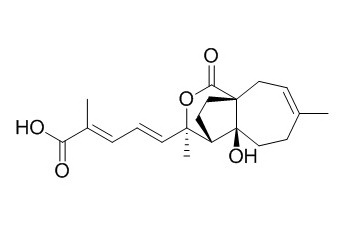Deacetylpseudolaric acid A
Deacetylpseudolaric acid A is a natural product from Pseudolarix amabilis.
Inquire / Order:
manager@chemfaces.com
Technical Inquiries:
service@chemfaces.com
Tel:
+86-27-84237783
Fax:
+86-27-84254680
Address:
1 Building, No. 83, CheCheng Rd., Wuhan Economic and Technological Development Zone, Wuhan, Hubei 430056, PRC
Providing storage is as stated on the product vial and the vial is kept tightly sealed, the product can be stored for up to
24 months(2-8C).
Wherever possible, you should prepare and use solutions on the same day. However, if you need to make up stock solutions in advance, we recommend that you store the solution as aliquots in tightly sealed vials at -20C. Generally, these will be useable for up to two weeks. Before use, and prior to opening the vial we recommend that you allow your product to equilibrate to room temperature for at least 1 hour.
Need more advice on solubility, usage and handling? Please email to: service@chemfaces.com
The packaging of the product may have turned upside down during transportation, resulting in the natural compounds adhering to the neck or cap of the vial. take the vial out of its packaging and gently shake to let the compounds fall to the bottom of the vial. for liquid products, centrifuge at 200-500 RPM to gather the liquid at the bottom of the vial. try to avoid loss or contamination during handling.
Anal Sci.2019, 35(12):1317-1325
Bioorg Med Chem.2018, 26(14):4201-4208
Appl Microbiol Biotechnol.2018, 102(12):5105-5120
J Appl Biol Chem.2024, 67:47,337-343.
Applied Biological Chemistry2020, 63:33(2020)
J Ethnopharmacol.2017, 197:157-164
Nutraceuticals2022, 2(3),150-161
Sci Rep.2021, 11(1):11936.
J Ethnopharmacol.2016, 192:370-381
Food Chem.2017, 228:301-314
Related and Featured Products
Yao Xue Xue Bao. 2014 Aug;49(8):1169-74.
Metabolic pathway and metabolites of total diterpene acid isolated from Pseudolarix kaempferi.[Pubmed:
25322560 ]
The preliminary metabolic profile of total diterpene acid (TDA) isolated from Pseudolarix kaempferi was investigated by using in vivo and in vitro tests.
METHODS AND RESULTS:
Pseudolaric acid C2 (PC2) was identified as the predominant metabolite in plasma, urine, bile and feces after both oral and intravenous administrations to rats using HPLC-UV and HPLC-ESI/MS(n), and demethoxydeacetoxypseudolaric acid B (DDPB), a metabolite proposed to be the glucoside of PC2 (PC2G), as well as pseudolaric acid C (PC), pseudolaric acid A (PA), pseudolaric acid A O-beta-D glucopyranoside (PAG), pseudolaric acid B O-beta-D glucopyranoside (PBG) and Deacetylpseudolaric acid A (DPA) originated from TDA could also be detected. It was demonstrated by tests that the metabolism of TDA is independent of intestinal microflora, and neither of pepsin and trypsin is in charge of metabolism of TDA, TDA is also stable in both pH environments of gastric tract and intestinal tract. The metabolites of TDA in whole blood in vitro incubation were found to be PC2, DDPB and PC2G, which demonstrated that the metabolic reaction of TDA in vivo is mainly occurred in blood and contributed to be the hydrolysis of plasma esterase to ester bond, as well as the glucosylation reaction.
CONCLUSIONS:
These results clarified the metabolic pathway of TDA for the first time, which is of great significance to the in vivo active form and acting mechanism research of P. kaempferi.
J Chromatogr A. 2012 Apr 27;1235:34-8.
Application of step-wise gradient high-performance counter-current chromatography for rapid preparative separation and purification of diterpene components from Pseudolarix kaempferi Gordon.[Pubmed:
22424731]
In general, simultaneously separation and purification of components with a broad polarity range from traditional Chinese medicine (TCM) is a challenge by an ordinary high-speed counter-current chromatography (HSCCC) method.
METHODS AND RESULTS:
In this paper, we describes a rapid and efficient separation method of combining three-step gradient elution and two-step flow-rate gradient elution using high-performance counter-current chromatography (HPCCC) to separate 8 diterpene compounds simultaneously within 80 min in a single run from the alcohol extract of Pseudolarix kaempferi Gordon. This separation process produced 166 mg pseudolaric acid B O-β-d-glucopyranoside (PABGly), 152 mg pseudolaric acid C (PAC), 8 mg Deacetylpseudolaric acid A (deacetylPAA), 5 mg pseudolaric acid A O-β-d-glucopyranoside (PAAGly), 484 mg pseudolaric acid B (PAB), 33 mg pseudolaric acid B methyl ester (PAB methyl ester), 10mg pseudolaric acid A (PAA) and 18 mg pseudolaric acid H (PAH) from 1.0 g crude sample with purities of 98.6%, 99.6%, 92.3%, 92.2%, 99.2%, 99.4%, 98.3%, 91.0%, respectively.
CONCLUSIONS:
Our study indicates that the suitable combination of step-wise gradient elution and flow-rate gradient elution using HPCCC is an effective strategy to separate complex components from natural products.



